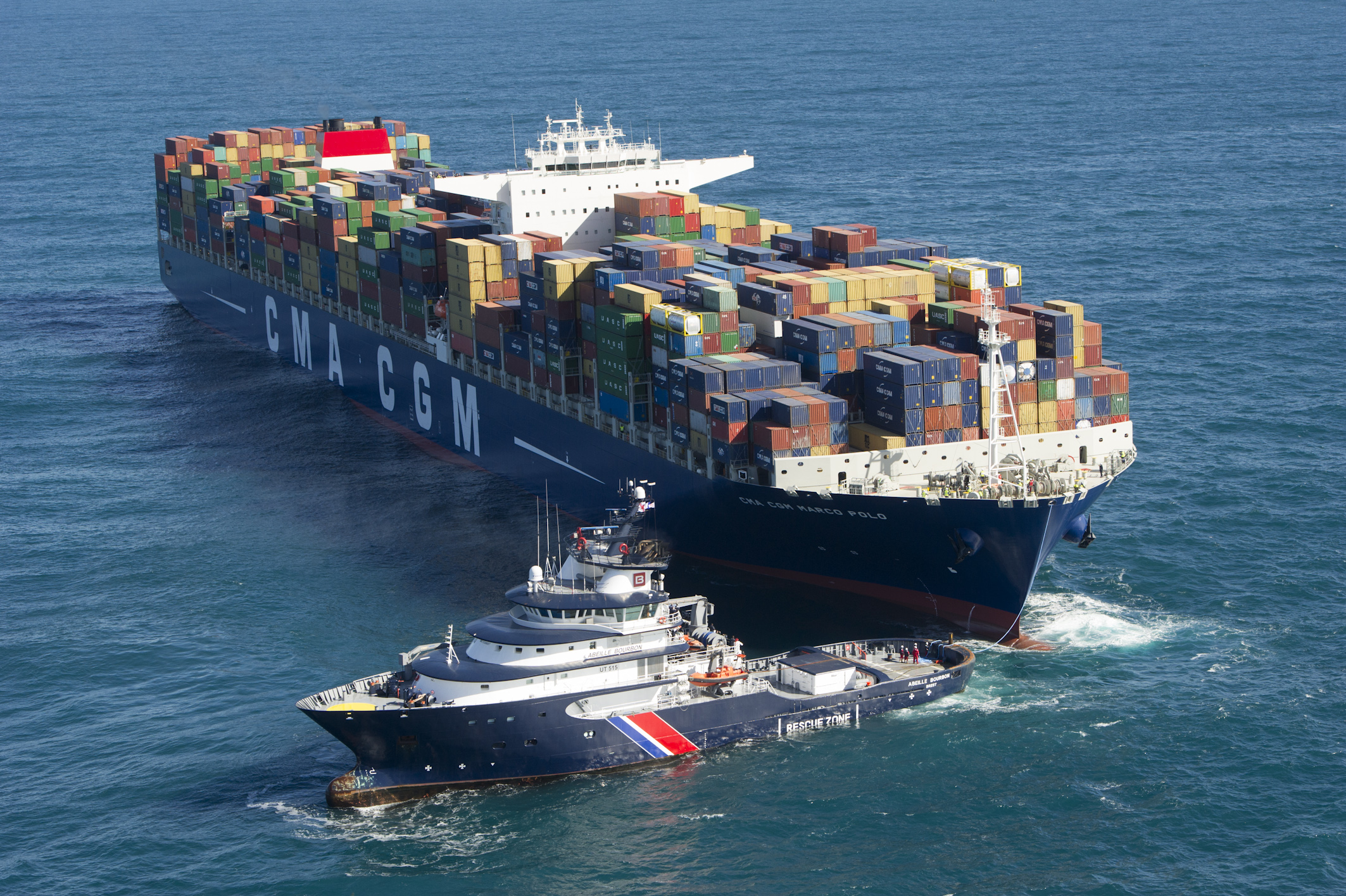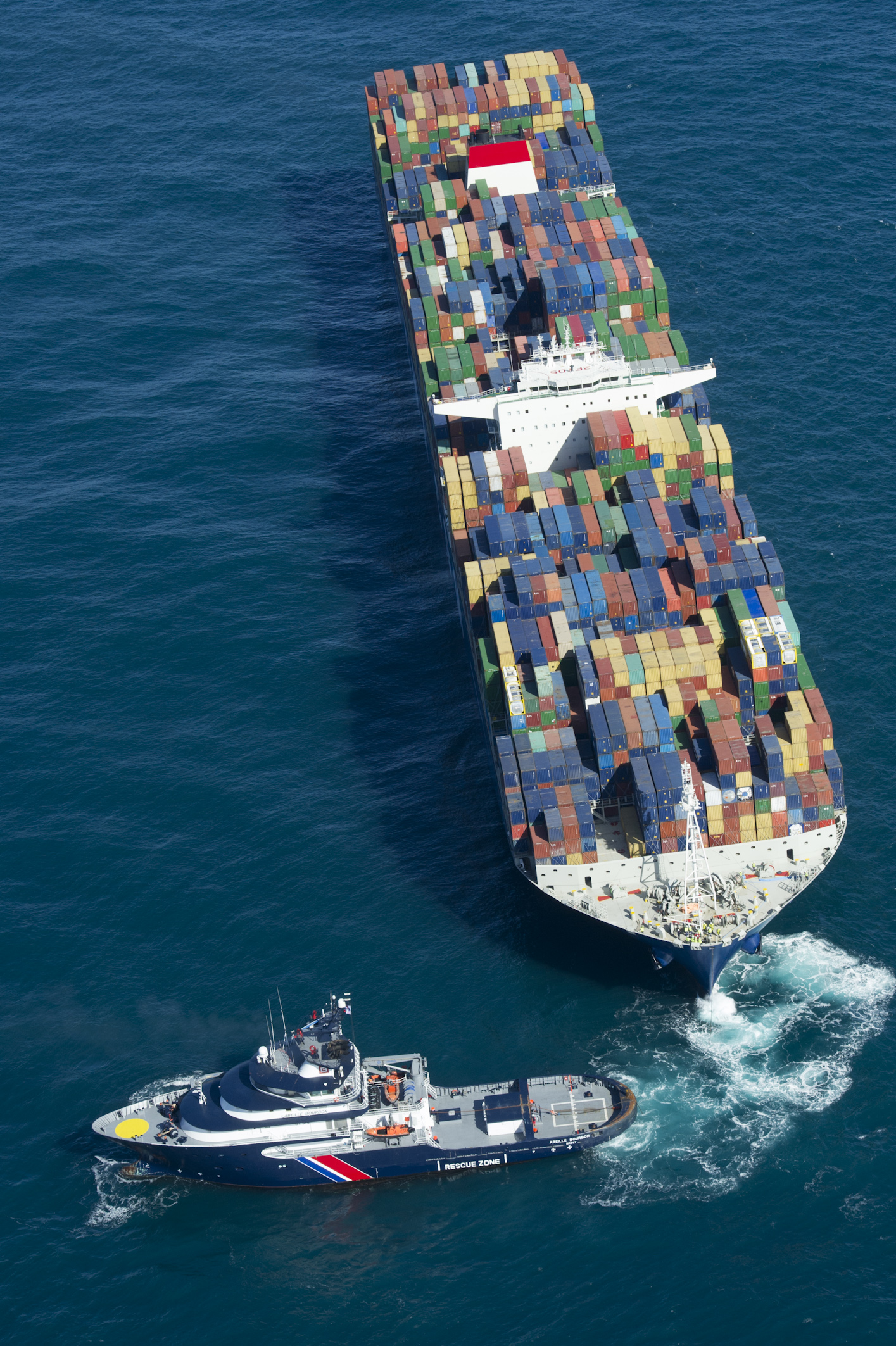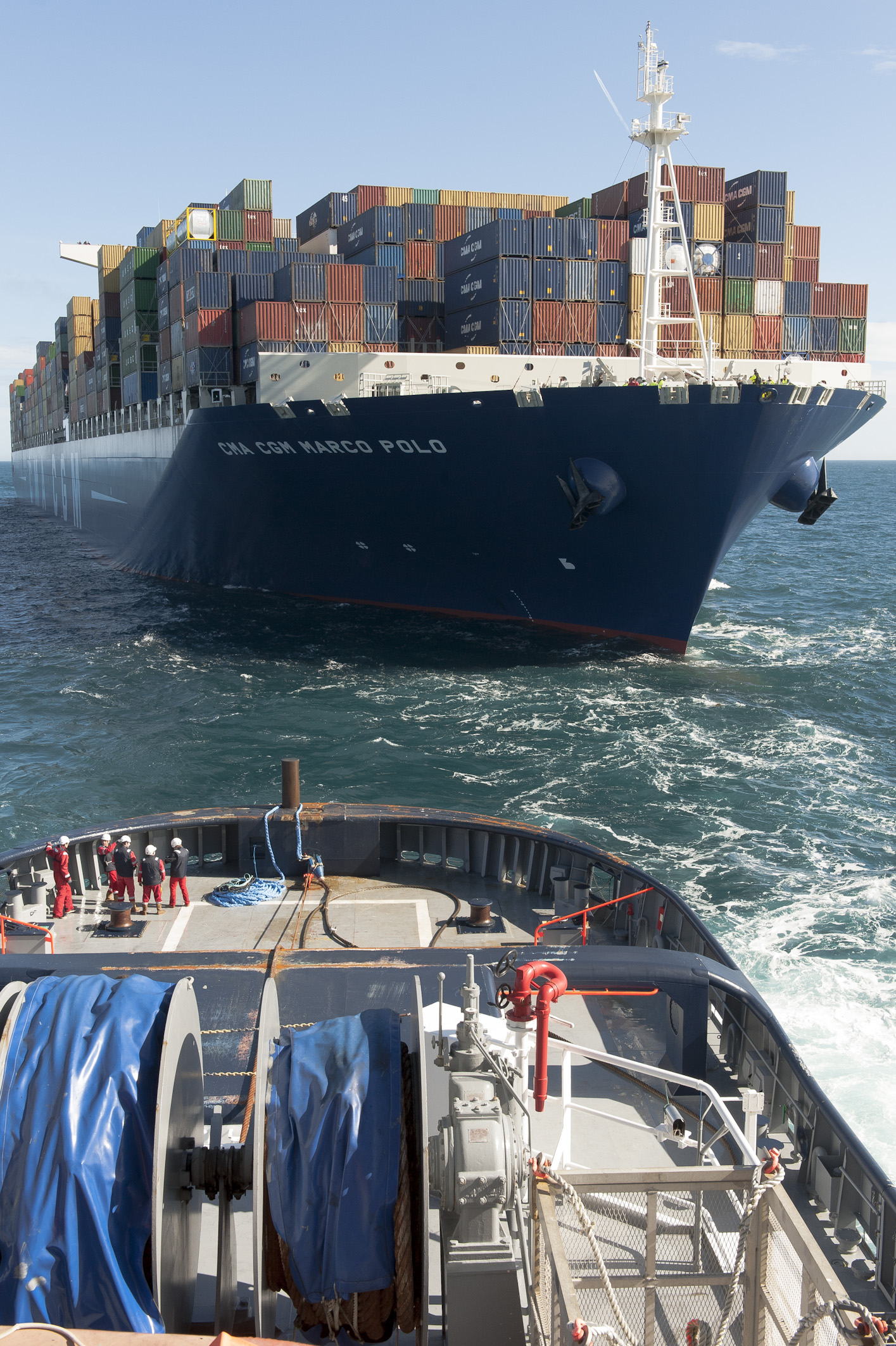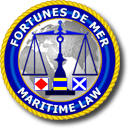Newsletter
Last published articles
Related Articles
Calendar
Login
CMA-CGM MARCO POLO : Impossible to salve and to tow ? No, but...
- Details
- Category: News
- Created on 14 March 2013
 Even if the event took place shortly after our publication on the subject, there is certainly no chance that the exercise has just taken place off the Brittany coats is a direct result of our article related to the potential problems of towing vessels such as the CMA-CGM MARCO POLO.
Even if the event took place shortly after our publication on the subject, there is certainly no chance that the exercise has just taken place off the Brittany coats is a direct result of our article related to the potential problems of towing vessels such as the CMA-CGM MARCO POLO.
Thus, enroute for Asia, CMA-CGM Marco Polo did a little "break" off the coast of Brittany to participate in an exercise organized by the "Prefecture Maritime de l'Atlantique" (depending on Defense Ministry). This administration was indeed concerned whether rescue facilities currently positioned at the tip of Finistère is sufficient to assist, if necessary, the largest commercial ships currently in operation. Because, although the "Abeille Bourbon" and her sister ship the "Abeille Liberté" (units of 80 meters and 209 tons of towing capacity the hook), are probably one o of the most powerful tugs in Europe, shipping industry has continued since their construction in 2005, its race to gigantism. This trend is particularly true for container and cruise ships that are now huge and characterized in particular by a strong wind effect.
The "Préfecture Maritime" therefore wished to train the staff dedicated to rescue and validate, at sea, the theoretical procedures in place to manage an incident (or accident) involving such a giant container ship, which could drift to French coast. It as to be reminded that in such cases, the risk is the shipwreck with the loss of thousands of containers, boxes adrift with many risks for the navigation of other vessels, but also for people should they finally strand on the coast (number of containers contain hazardous materials).
The chosen scenario was an engine breakdown. As soon as it was known from the coastal authorities, a rescue team was transporter by helicopter on board the CMA CGM Marco Polo, whose mission is to assess the situation and prepare rescue operations, in connection the Rescue Coordination Center (this assessment must also be made within the framework of the regulations regarding port refuges). The tug "Abeille Bourbon" sent a towline to the ship of 396 meters long and 53 meters wide (capacity of 16,020 TEUs). After this operation, it was a "normal" towing operation ie stop the Marco Polo, drift of the ship, sending of towing lines, towing the vessel, and finally release and recovery of the towline. "
The REX (Return of Experience) of this exercise is interesting because if the operation on 9 March was a success, the problem of saving this type of vessel has not really found completely satisfactory answers. Among the things that can be already retained is that you can have a beautiful weather in Brittany in March (what we say " un temps de curé), including at sea and that weather allowed the Marine Nationale photographers Marine, Alain Monot and Sébastien Deschamps to take stunning images on this operation. I quote willingly their names because many times in the past, I published their photos on this site, without ever specifically mention the author; I attempt to redeem these past mistakes.
Among the things that can be already retained is that you can have a beautiful weather in Brittany in March (what we say " un temps de curé), including at sea and that weather allowed the Marine Nationale photographers Marine, Alain Monot and Sébastien Deschamps to take stunning images on this operation. I quote willingly their names because many times in the past, I published their photos on this site, without ever specifically mention the author; I attempt to redeem these past mistakes.
More seriously, the exercise made me lie, at least partially, in showing that it is indeed possible to tow such sea monsters. But I do not admit me completely defeated because the reference to this beautiful weather (temps de cure) is not so trivial. That the exercise took place in ideal conditions and exceptional is a pleonasm, as they could be radically different at this period of year (as we have few days ago off our coasts and on our roads...).
Also, the weather was probably a little too favorable to perfectly illustrate a "real" situation" and maneuver would surely have been much more complex with an equinox storm. In case of bad weather, and therefore much stronger constraints on the towline and the mooring bitts and fairlead, the towing would have been more difficult. Similarly, the exercise was performed with a ship departing from Europe, that is to say, far from its maximum capacity (the container ships arriving from Asia are full but leave with about 30% or less empty boxes), does not validate the feasibility and reproducibility of the operation.
Some questions remains, especially as it must be recalled that in 2007, the "Abeille Bourbon" and the "Abeille Liberté" were just enough to tow the MSC Napoli (ex-CGM Normandie), which characteristics (275 meters long, 2700 containers) were quite far from the CMA-CGM Marco Polo.
We have to add that the hypothesis of the damage sustained by the vessel was finally the case that pose fewer problems to authorities with this type of vessel. If it remains plausible, the latest examples of major disasters involving ships of this type (MSC NAPOLI or MSC NAPOLI FLAMINIA) showed that the meteorological circumstances or condition of the vessel could to threat attempts to tow or make them particularly difficicult. With regard to the MSC NAPOLI, who suffered from cracks that may at any time cause tearing of the vessel, towing had been shortened and the vessel was voluntarily stranded in a shallow UK bay. For the MSC FLAMINIA, which was partially destroyed by fire and had encountered severe weather conditions, which had no propulsion, it remains the illustration of the total fiasco of the "port refuge" legislation and his application by the coastal States. This is why the analysis of the results of the exercise of March 9th will inevitably viewed with a magnifying glass and lead to improve procedures, to better gauge the effectiveness of the equipment according to the different scenarios, and if necessary, strengthen the rescue means in Britain and possibly in the Bay of Biscay, where there is no more ocean salavage tug since the departure of the Abeille Languedoc to the Strait of Pas-de-Calais, in 2011.
This is why the analysis of the results of the exercise of March 9th will inevitably viewed with a magnifying glass and lead to improve procedures, to better gauge the effectiveness of the equipment according to the different scenarios, and if necessary, strengthen the rescue means in Britain and possibly in the Bay of Biscay, where there is no more ocean salavage tug since the departure of the Abeille Languedoc to the Strait of Pas-de-Calais, in 2011.
As emphasized in the web magazine "Mer et Marine", France has been a pioneer and consents major efforts with the largest European ocean salvage network. But these means, from a more or less inevitable and satisfying compromise between risk and financial constaints remain limited compared to some disaster scenarios. They must also be regularly adapted to the evolution of the "threat", as is the case for example with increasing size of vessels in shipping and cruising. While some countries, due to budgetary restrictions, revise downward their resources allocated to rescue the idea made its way to expand this question not only national, but also in Europe. The latter, through the European Maritime Safety Agency (EMSA), created in 2006 following the sinking of the Erika (1999) and Prestige (2002) has already implemented several actions, including the creation of a fleet of ships in charge of depollution. But assistance and towing questions remain managed nationally. However, as we are reminded regularly-and rightly so-the French authorities, the majority of vessels transiting to the UK and Channel are not to or from France. Yet, it is France that ensures alone, or almost, the safety of the traffic, including the economic benefit to foreign ports, including the United Kingdom, the Netherlands, Belgium or Germany ...
To conclude, we could say "Duly noted and next step, next year, in more difficult weather conditions (no steering for example together with no propulsion....) and most importantly, the next ship in distress will have be taken in charge, towed, and bring safely in a port of refuge, an "ambitious program" as may tell our politicians.
© Marine Nationale













































